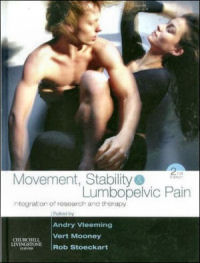Chiropractic and Health Books
Movement, Stability & Lumbopelvic Pain: Integration of research and therapy
 Movement, Stability & Lumbopelvic Pain: Integration of research and therapy
Movement, Stability & Lumbopelvic Pain: Integration of research and therapy
Check New and Used Prices
The human pelvis has become a focus for a considerable amount of new research, which is relevant to manual therapy practice. In particular, movement within the pelvis is now being recognized and studied in relation to its role in maintaining stability in the vertebral column and subsequent implications for the prevention and treatment of low back pain. This important subject area is covered in depth in this new edition. The contributors represent the breadth of professionals involved in manual therapy, from osteopathy, chiropractic and manual physical therapy, to orthopaedic medicine and surgery, anaesthesia and pain control.
Key Features
Evidence -based focus
Final conclusions including perspectives with each chapter
Each chapter is relevant and up to date
New to This Edition
New high profile contributors
Updated references
Introduction and closure for each chapter
Special attention given to stability and muscle function
Table of Contents
PART 1 Biomechanical, clinical-anatomical and evolutionary aspects of lumbopelvic pain and dysfunction
SECTION 1 Clinical-anatomical aspects
1. The muscular, ligamentous and neural structure of the lumbosacrum and its relationship to low back pain, FH Willard
2. Anatomical linkages and muscle slings of the lumbopelvic region, C DeRosa, J Porterfield
3. Anatomy and biomechanics of the lumbar fasciae: implications for lumbopelvic control and clinical practice, PJ Barker, CA Briggs
4. Clinical anatomy of the anterolateral abdominal muscles, DM Urquhart, PW Hodges
5. Clinical anatomy of the lumbar multifidus, L Danneels
6. Clinical anatomy and function of psoas major and deep sacral gluteus maximus, S Gibbons
7. The SIJ, sensory-motor control and pain, A Indahl, S Holm
8. The role of the pelvic girdle in coupling the spine and the legs: a clinical-anatomical perspective on pelvic stability, A Vleeming, R Stoeckart
SECTION 2 Evolution, biomechanics and kinematics
9. Evolution of the human lumbopelvic region and its relationship to some clinical deficits of the spine and pelvis, CO Lovejoy
10. Kinematic models and the human pelvis, A Huson
11. How to use the spine, pelvis and legs effectively in lifting, MA Adams, P Dolan
12. Is the sacroiliac joint an evolved costovertebral joint? S Gracovetsky
13. The evolution of myths and facts regarding function and dysfunction of the pelvic girdle, D Lee
PART 2 Insights in function and dysfunction of the lumbopelvic region
14. Anatomical, biomechanical and clinical perspectives on sacroiliac joints: an integrative synthesis of biodynamic mechanisms related to ankylosing spondylitis, AT Masi, M Benjamin, A Vleeming
15. A suspensory system for the sacrum in pelvic mechanics: biotensegrity, SM Levin
16. Why and how to optimize posture, RE Irvin
17. Gait style as an etiology to lower back pain, HJ Dananberg
18. A detailed and critical biomechanical analysis of the sacroiliac joints and relevant kinesiology: the implications for lumbopelvic function and dysfunction, RL DonTigny
19. Stability or controlled instability? S Gracovetsky
PART 3 Diagnostic methods
SECTION 1 Visualization in relation to pelvic dysfunction
20. Basic problems in the visualization of the sacroiliac joint, PF Dijkstra
21. CT and MRI of the sacroiliac joints, JMD O’Neill, E Jurriaans
22. Visualization of pelvic biomechanical dysfunction, T Ravin
SECTION 2 The pelvic girdle
23. Movement of the sacroiliac joint with special reference to the effect of load, B Sturesson
24. What is pelvic girdle pain? HC Ostgaard
25. The pattern of intra-pelvic motion and lumbo-pelvic muscle recruitment alters in the presence of pelvic girdle pain, B Hungerford, WGilleard, P Hodges, D Lee
SECTION 3 Low back
26. Different diagnosis of low back pain, SV Paris
27. Conditions of weight bearing: asymmetrical overload syndrome (AOS), JA Porterfield, C DeRosa
28. Evidence-based clinical testing of the lumbar spine and pelvis, M Laslett
PART 4 Guidelines
29. European guidelines for prevention in low back pain, G Muller on behalf of the COST B13 Working Group on European Guidelines for Prevention in Low Back Pain
30. Evidence-based medicine for acute and chronic low back pain: guidelines, M van Tulder, B Koes
31. European guidelines on the diagnosis and treatment of pelvic girdle pain, A Vleeming on behalf of the COST B13 Working Group on European Guidelines for Diagnosis and Treatment of Pelvic Girdle Pain
PART 5 Effective training and treatment
SECTION 1 Psychological, social and motivational aspects
32. Behavioral analysis, fear of movement/(re) injury and cognitive-behavioral management of chronic low back pain, JWS Vlaeyen, LMG van Cleef
SECTION 2 Motor control
33. Functional control of the spine, PW Hodges, J Cholewicki
34. Motor control in chronic pain: new ideas for effective intervention, G Lorimer Moseley
SECTION 3 Different views on effective training and treatment
35. The painful and unstable lumbar spine: a foundation and approach for restabilization, SM McGill
36. Important aspects for efficacy of treatment with specific stabilizing exercises for postpartum pelvic girdle pain, B Stuge, NK Vollestad
37. Breathing pattern disorders and back pain, L Chaitow
38. Effective rehabilitation of lumbar and pelvic girdle pain, V Mooney
PART 6 Integrating different views and opinions when dealing with a complex system
39. An intregrated approach for the management of low back and pelvic girdle pain – a case report, D Lee
40. An integrated therapeutic approach to the treatment of pelvic girdle pain, D Lee, A Vleeming
Movement, Stability & Lumbopelvic Pain: Integration of research and therapy
Check New and Used Prices